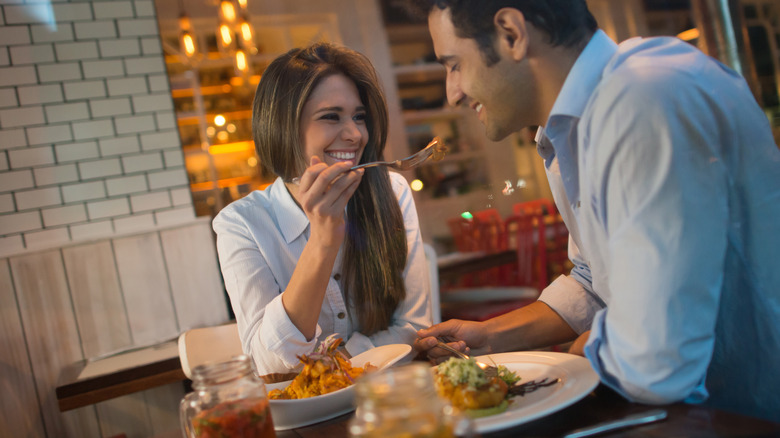Elbows Belong On The Table In Modern Day Dining Etiquette
Rules of etiquette aren't etched in stone. As times change, and cultures and fashions shift, sometimes our ideas about what constitutes good manners change, too. For example, those who lived 200 years ago would never have been able to predict crucial drive-through etiquette to remember on rainy days. Another good example? Look no further than the elbows on the table rule.
This rule might as well have been etched in stone. It has been around so long, it's actually mentioned in the Bible. Basically, the rule states that when dining with others, it's not polite to put one's elbows on the table. The reasons given for this rule have varied from era to era and culture to culture. In less enlightened times, for example, it was thought to prevent aggression and violence at the dinner table. More recently, elbows on the table were thought to promote slouching or unwanted food stains. For those of a certain age, the reasons were immaterial. The rule was learned — usually from parents — and it was expected to be followed.
But times have changed, and so too have some of the fundamental rules of etiquette, including this one. Oh, a few hidebound etiquette experts still insist that context matters when it comes to putting elbows on the dinner table. But nowadays, the practice is definitely considered acceptable. In fact, some have even argued that it has positive effects in regards to body language.
The evolution of the elbows on the table rule
Although it was mentioned in the Bible, the elbows on the table rule may have become commonplace during the Middle Ages and could have something to do with the tables of the time, which were often little more than poorly balanced trestles. Thus, resting one's elbows could actually upend the table, scattering plates in the process, and ruining perfectly good food. Societal concern with good manners increased during the Renaissance, mostly as a result of violence and aggressively bad behavior in fast-growing urban areas. By this era, the elbows on the table rule was commonly cited in learned texts, including a civility handbook for children written in 1530 by famed Dutch theologian Desiderius Erasmus.
In modern times, however, as rickety tables and violence became less common during dining-focused get-togethers, the rule has begun to be reevaluated. Emily Post, a famous 20th-century American arbiter of manners, led the charge in this regard. She thought it was wrong to have one's elbows on the table while eating, just from a commonsensical point of view, but felt it was okay otherwise. This then, for many etiquette experts, became the crucial distinction. When food is being served or is still taking up space on tabletops, elbows should remain at one's side. But during after-dinner conversations, elbows on the table are just fine.
Why the rule has changed over time
Some etiquette experts still subscribe to Emily Post's views on the rule, but in general, the rule has fallen completely out of favor. Why? It just seems too arbitrary and unnecessary. Post herself noted that it wasn't the manners themselves that were important, but rather respect and consideration for others. Nowadays, elbows on the table are more likely to be seen as positive, due to body language considerations. This posture tends to emphasize one's interest in what others are saying, especially when you're leaning in their direction.
When your dinner companion has assumed the elbows on-table posture and you follow suit, this is known as mirroring. Not only is it considered an excellent way to develop rapport with others, but it has also proven relationship benefits in social and business contexts. So instead of committing some social error or faux pas, putting your elbows on the table can actually work to your advantage at business lunches and dinners.
Remember: At any hosted lunch or dinner, one of the most important etiquette rules is to take your cues from the host to ensure you're being a good dinner guest. So if your host avoids putting his or her elbows on the table, then perhaps you should avoid doing so as well — not because it's a rule, but out of consideration for the host's preferences.



